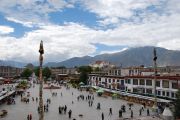After spending 44 hours on a trainfrom Chengdu, I made it to the "forbidden city". Lhasa the capital of Tibet means “God’s Land” or the “Palace of Deity” in Tibetan. Lha meaning God.
|
Lhasa rose to prominence as an administrative center in the 7th century when Songten Gampo (king of Tibet 620-649) moved his capital there and built a palace on the site now occupied by the Potala. He established the Tubo Kingdom.
The town is located at the northern bank of the Lhasa River also known as the Kyichu River, it has an elevation of 3658 meters. The city covers an area of 30000 square Km. Around 150000 people live in the city in which 82% are Tibetan according to the official statistics. The town is divided into 2 parts, the old town in the east around the Barkhor where the Tibetans are in majority. The other part located in the west around the Potala is the Chinese part.
|
|
| Favourite spots: |
The Jokhang is the most sacred and active temple in Tibet. It is less impressive than the Potala but does neet to for pilgrims to express their devotion. It has a history of over 1400 years, the construction started in 647. It was founded by Bhrikuti, King Songten Gampo’s Nepalese bride on a site chosen by his other wife Wengheng a Tang dynasty Princess as the principal geomantic power place in Tibet. By consulting astrological charts, she was told to construct the temple on this site reclaiming the land of the Othang Lake. She brought a statue with her to Tibet from China, the King was very impressed that he wanted a special chapel built for the statue, The statue was called the “Jowo”, a treasured statue of the Buddha Siddartha Gautama known in Tibet as Sakyamui. Jokhhang means “The shrine of Jowo”. Jowo means precious one in Tibetan.
I entered the inside of the temple; it was a marvel srtiking me! It was full of life with pilgrims murmuring prayers and some monks were praying.
|
|
| What's really great: |
 |
 |
 |
 |
 |
 |
 |
 |
Barkhor square from the roof of the Jokhang.
 |
 |
I moved on to the most important part of the temple, the chapel house the statue of Buddha Jowo Sakyamuni. Here it was more crowded as the crowds move more slowly. The statue was adorned with the white prayer scarf, the Katak. The pilgrims are truly devoted Sakyamuni is really sacred in Tibet. This statue is the ultimate goal for the Tibetan Pilgrims. It is said that the statue of the Jowo Sakhyamuni represents him when he was 12 years old. There was a wall painting depicting the legend of a goat who filled the lake with earth, making it possible to built the Jokhang and shows how King Songtesen Gampo came to built the Jokhang. My visit continued by climbing some steep steps to reach the roof of the Jokhang. It was amazing to see the gilded roof with the Wheel of Law (Dharma Wheel) and other ornaments. The roof offered splendid views over the Barkhor Square and the Potala Palace.
After, I entered the Barkhor circuit, or the Kora letting myself dragged by the flow of pilgrims.
|
|
| Sights: |
|
On the Barkhor square there were stalls vending mainly prayer flags. I was watching the pilgrims making their way to the Jokhang most of them probably walk days to reach that point. Barkhor Square is a large plaza which was renovated in 2000, before that it was infested with rubbishes and rats. At the entrance of the Jokhang, I turned left and started to do the circuit around the Jokang Palace called “The Barkhor”, the act of accomplishing the circuit is called a Kora. The Kora is a clockwise pilgrimage around a holy site such as a temple, monastery, mountain or a lake. This circuit is the most famous in Lhasa’s pilgrimage and is the best introduction to a new visitor to Lhasa. The Kora must be done clockwise.
|
|
| Accommodations: |
I stayed at the Yak Hotel, in the the Barkhor area.
Some pilgrims invited me to join them, I did not know where I was, or either where they were going, but having a taste for adventure I decided to join them for the experience. They walked as they turned a manikhor (prayer wheel). To my surprised after a few minutes, as by magic the Potala appeared in front of me, perched on its hill. The Potala Palace towering over Lhasa is the landmark of Tibet. The Potala is perched on Marpo Ri or Red Hill at the western end of Lhasa. Potala means “The Palace where Avalokiteshvara Lives” of whom the Dalai Lama is the embodiment. Avalokiteshvara was the Bhuddha of compassion and is the Political and Religiious head of the country.
The Potala is 119 metres high from top to bottom. The Potala measures 350 metres from east to west and 270 metres from north to south. The complex is 130000 metres squares.
|
|
| Nightlife: |
I saw the Dalai Lama old quarters as well as the impressive tombs of the 5th Dalai Lama. It is 14 metres high and is decorated with 3700Kgs of gold as well jewels.
I made my way to the entrance of the Potala Kora, the pilgrim circuit encircling the Potala Palace. The circuit was continuous with prayers wheels fixed to its outside walls. I continued the Kora spinning the wheels to divert into the Lukhand Park, where I could see the unusual view of the back of the Potala. There was a small lake, on the lake there was a small island with a temple. When I reached the island it was Lukhang Temple, it was very pretty.
The Lukhang temple facing the back of the Potala Palace on the lake is dedicated to Naga, or water dragons, it dates from the 17th century being built by the 6th Dalai Lama.
|
|
| Hangouts: |
I also went to see the Palhalupuk monastery; it was built during the King Songtan Gampo’s time in the 7th century as he used it for his retreat. It is the hidden jewel of Lhasa, the inside is so nice and atmospheric, there is small cave with some rock carvings over 1000 years old. At the centre of the temple there is a statue of Sakyamuni, in the back of the temple hidden there is small statue of Palden Lhamo the goddess protector of Lhasa. This temple is really a gem; I talked a bit with the monk at the entrance. I made my way upstairs, there is also a smaller cave. I found a monk reciting mantras, he was almost not breathing in between, amazing. From the terrace I also had great view of the Potala Palace.
|
|
| Restaurants: |
You will not starve in Lhasa!
I went to the blind school “Braille without borders”, the school was founded in 1998 by a young blind German. I was met by her as she gave me a visit. She told that at the begining blind children where often kept lock up and regarded as stupid, with her school, it offers possibility for some blind children to get a normal life, but infortunatley there are not enough beds to please every one. Children become blind because of the sun ultra violets, but as well with the smoke from the indoor fire causing infections to the eye. Sabrina was really amazing, she knows where she is going, and is very determined, I admire her courage! The school mainly subsist on donations.
|
|
| Other recommendations: |
Drepung Manastery : The monastery is perched on hill offering views over the city of Lhasa. Drepung was built in 1416 and is the largest monastery in the Gulupa sect. In 1641 it housed over 10 000 monks. Drepung became an important centre of political power and housed the Dalai Lama before the construction of the Potala Palace.
I first enter the Ganden Palace; the assembly hall was nicely decorated with statues of gods and other religious artefacts, musical instruments such as drums and horns. I moved on to other chapels, it was amazing, full of life with pilgrims visiting the temple and chanting monks or reading scriptures as part of their daily routine. It was very enlightening, the burning Choeme, or yak butter lamps gave a special atmosphere to the chapels.
|
|
Published on Saturday November 29th, 2008
|
|
 Publish on Facebook
Publish on Facebook
|
Sun, Dec 07 2008 - 11:12 AM
 by rangutan
| Excellent info and feelings, a lot of time went into this. Great images too. |
Mon, Dec 01 2008 - 02:13 PM
 by jorgesanchez by jorgesanchez
une merveille....
salut depuis timbuktu... |
Sun, Nov 30 2008 - 01:55 PM
 by marianne by marianne
| Isabell, What a pleasure to read, as if I were there myself. |
Sun, Nov 30 2008 - 06:47 AM
 by krisek by krisek
| Isabelle, a great report with beautiful photographs. Thank you. |
Sat, Nov 29 2008 - 09:17 AM
 by pesu by pesu
| Thanks a lot, Isabelle, for this report about your fascinating Tibet experience. It is full of interesting information. The pics are beautiful. Fine that you also gave a hint to Sabrina's school for blind children. |
Sat, Nov 29 2008 - 09:06 AM
 by davidx by davidx
| Fine report, Isabelle. I do envy you for seeing all this. |
| Information: |
| Login if you are a member, or sign up for a free membership to rate this report and to earn globo points! |
|
| Belarus |
|
|
 |
| Bhutan |
|
|
|
|
 |
| China |
|
|
|
|
 |
| Mongolia |
|
|
|
|
 |
| Nepal |
|
|
 |
| Peru |
|
|
 |
| Russia |
|
|
|
|
|
|
|
|
|

|
